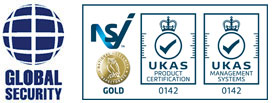All businesses, no matter how big or small, need to protect their premises against intruders, which is why it is important to have good-quality security systems installed.
As well as alarms that give an alert when someone has entered the building without authorisation, it is sensible to invest in biometric control systems, as these restrict entrance only to those who have been recognised on the system.
There are different options when it comes to biometric access control systems, so it can be difficult for businesses to know which one would be best for their needs. Here we look at the various technologies to help companies find one that fulfils their security requirements.
Fingerprint access
Lots of businesses only allow access to their buildings to those who have been registered on their fingerprint reader. This means they have been authorised and all their details taken down. Therefore, the company knows everything about them and they have been thoroughly checked first.
This also means the business can track them down and withdraw access, if they are deemed later to be untrustworthy.
Fingerprint recognition is useful in buildings where there are lots of secured doors, as it allows staff to be able to move around departments without having to remember different pin codes or requiring other employees to approve access.
Many fingerprint access control systems allow up to 10,000 users, providing more than enough capacity for most businesses.
They are a secure option, as only those with the approved fingerprints will be allowed in, and live finger detection (LFD) technology means they are checked against the system very quickly. In fact, many can identify a registered user in a fraction of a second.
Fingerprint door systems can be used both internally and externally, as they are weather proof, so businesses can maintain a high level of security even in inclement conditions, as it does not matter if the technology gets wet.
Face recognition systems
Another option is installing face recognition technology, such as the FaceStation. Instead of using the user’s fingerprint to identify them, it takes a scan of their face.
Its adaptive IR illumination combines near-infrared light control, together with image analysis, which means image distortion can be avoided. At the same time, its advanced detection ability means only those with authorised access can gain entry.
Therefore, even imitated face images will be detected and not be given access. The fact that the technology works with an analysis algorithm, which is able to detect particular features in the face to determine true identity, really makes these systems stand out.
Even though it offers a very thorough scan, it can match faces with their data incredibly quickly, providing a speed of up to 1,000 matches per second.
Businesses might be tempted to go for a face recognition system, as they are able to withstand high traffic. They also can be part of a larger network of security features, helping companies to maintain access control throughout the premises.
Another impressive feature of the face recognition system is that some models also have a high temperature detection. Therefore, it picks up on objects even in fog, smoke or complete darkness, which means intruders who are trying to enter when visibility is low can still be seen.
It also enables companies to detect early signs of illness, which might be important in particular settings or during certain times, such as throughout the Covid-19 pandemic. If a high temperature is noted, this can signal an alarm and prevent the user access to the building, potentially avoiding other people from contracting the illness.
However, it is worth noting that these systems will not be able to detect a virus, such as Covid-19, if the person is asymptomatic, at an early stage of their illness, or does not have a fever at the time.

Leave A Comment